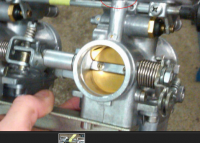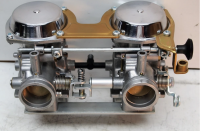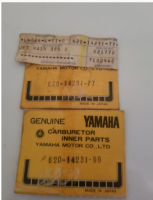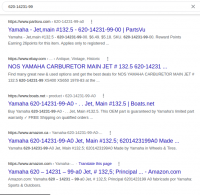In your pic yes, the left screw is for sync and the right screw is for idle speed adjustment. There is no "stock" setting for these, you just put them where they need to be to accomplish their job. The sync screw controls the opening on the right carb's butterfly plate. You adjust it so it matches the opening on the left carb's plate. This "syncs" the carbs, gets them running at the same speed. Then you set the idle speed with the adjustment screw on the left carb. The butterfly plates are tied together through the linkage so adjusting the idle speed screw moves them both in unison.
OK, so you've messed with the settings. I'll walk you through what's called a "bench sync" to get them back very close to where they need to be. Final adjustment and setting to get them perfect will have to wait until they're back on the bike and it's running. Start by backing off the idle speed screw enough so it's not touching the cable arm at all, so you can actually see a space between the two. This will allow both butterfly plates to close completely. Now, hold the air filter ends on the carbs up to a good light and look in the engine side at the butterfly plates. If the carbs are in sync, both plates will be closed completely and you'll see little, if any, light coming through around the edges. If out of sync, one plate will be open more than the other and show more light around the edges. Now, start playing with the sync screw. Turn it in or out, what ever it takes, to close up the open plate. You'll know in a turn or so if you're going in the right direction because the open plate will begin to close up or open more. Once the open plate closes, continue turning the screw until the other plate just begins to open. Now turn it back in the opposite direction until the 1st plate starts opening again. Sync will be half way between those two points so work the screw back and forth and find that spot as best you can. Now you can re-set the idle speed. Turn the idle speed adjustment screw on the left carb back in until both butterfly plates are cracking open just a hair. This is usually somewhere in the range of one to two turns in after the screw makes contact with the cable arm.
This will get the sync and idle speed very close, good enough to start and run the bike. As I said, the final adjustment to get things perfect will need to be done now (gauges for sync, idle speed setting to 1100-1200 RPMs hot).






